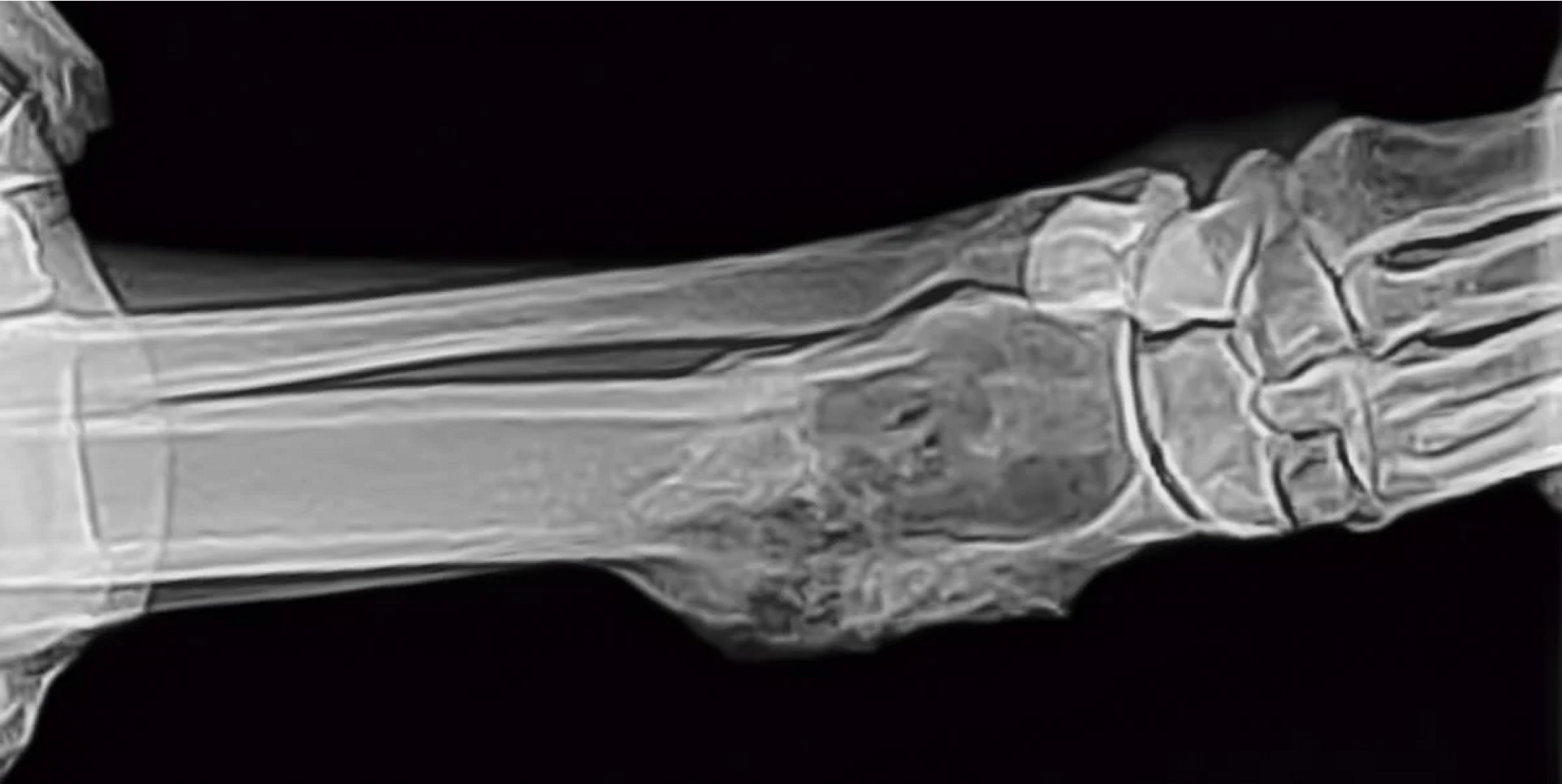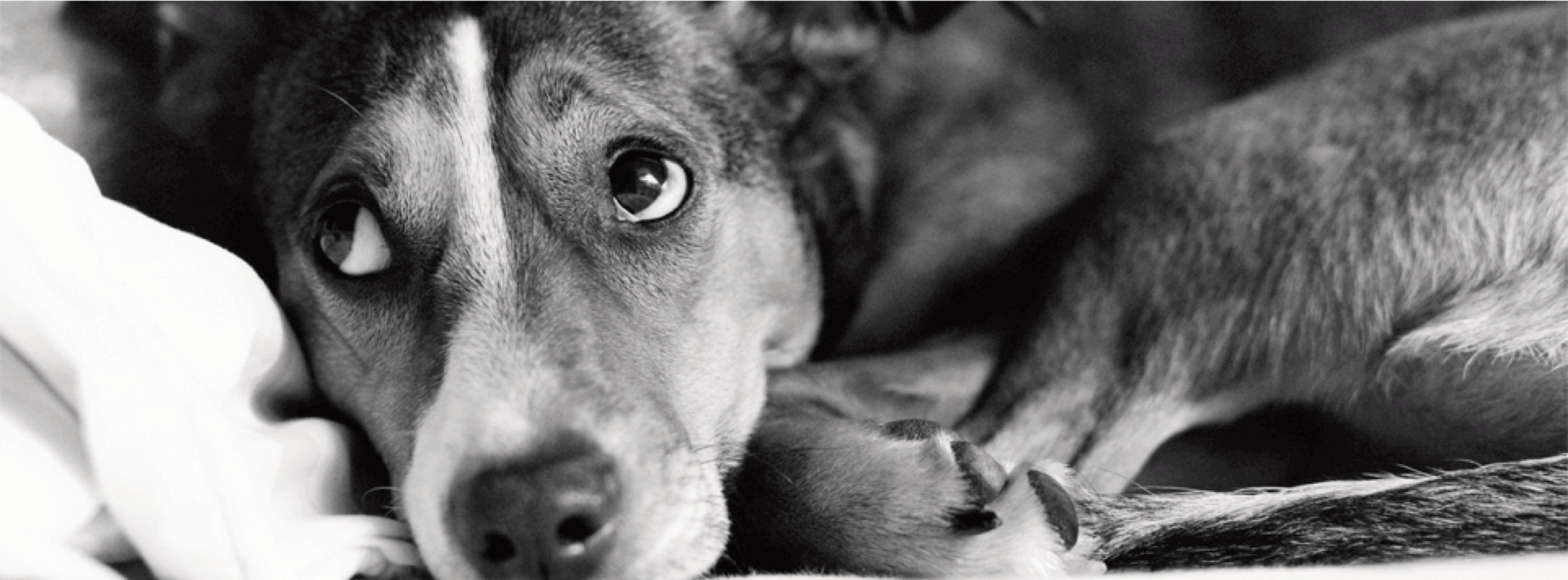Last Updated: 07/05/2025
Osteosarcoma in Dogs
Learn all about osteosarcoma in dogs - the breeds most at risk diagnosis treatment and prognosis.
Author: Dr Brittany Ward BVSc
Reading Time: 32 minutes - long read























Last Updated: 07/05/2025
Learn all about osteosarcoma in dogs - the breeds most at risk diagnosis treatment and prognosis.
Author: Dr Brittany Ward BVSc
Reading Time: 32 minutes - long read























Has your dog recently been diagnosed with Osteosarcoma? Or maybe you are a prospective puppy owner researching your favourite breed, and you've just found out they are a breed prone to osteosarcomas? This article dives into everything thing you'll need to know about Osteosarcomas and how you can support your dog after diagnosis.
Contents:
Osteosarcoma is the medical term for bone cancer. By breaking down the name, we get 'osteo' for bone and the suffix sarcoma which indicates a malignant tumour. Osteosarcomas are the most commonly occurring bone cancer in dogs and are typically diagnosed in the limbs; called appendicular osteosarcoma. However, it can occur in any bone within the body.
Like most cancers, there is no specific cause known for Osteosarcomas. It carries the same risk factors as any other cancer, although there may be a genetic component given that some breeds are more prone to getting bone cancers.
Osteosarcomas can occur in any breed at any age, but is more commonly seen in large and giant breed dogs. Studies have found that breeds over 40kg, those with longer muzzles/skulls and longer legs are at the highest risk. However, some specific breeds tend to be over-represented in presenting cases, including:
•Scottish Deerhound
•Irish Setter
•Newfoundland
•Saint Bernard
Lethargy
Loss of appetite
Reduced activity
Fever
Weightloss
Depression
Shaking or shivering
Breathing difficulty
Nasal discharge
It is important to be aware of the less specific symptoms of Osteosarcoma and get your dog checked if they are showing any signs of being unwell as Osteosarcomas are often diagnosed late, reducing treatment options.
Osteosarcomas damage the affected bones and can weaken them. This can mean that the bone can break during normal activity. Some osteosarcomas may only be diagnosed when the dog presents for this fracture.
If your pet is showing signs of Osteosarcoma, they will need to be taken to the vet. Your vet will perform a complete examination to assess their health and any visible tumours.
If your vet suspects an Osteosarcoma, they will recommend X-rays. Osteosarcomas are cancers of bone cells, so show cancerous bone growth as well as bone destruction on an X-ray. They are often described as having a "moth-eaten" appearance. If your dog has a fracture as well, this will also be visible on X-ray.
While they are sedated they will sample the tumour with fine needle aspiration. This will allow them to look at the type of cells involved under the microscope and confirm the diagnosis of Osteosarcoma. Fine Needle Aspiration often cannot be done while patients are awake as Osteosarcomas are very painful.
When Fine Needle Aspirate is unsuccessful, a bone biopsy may be required for definitive diagnosis.
Before your vet makes treatment recommendations, they will stage the Osteosarcoma. There are three stages used for this condition. This type of tumour is highly aggressive and spreads rapidly. Often at the time of diagnosis, the cancer will have already metastasised (spread) into other parts of the body (Stage III). A common location for these is in the lungs, which is why many vets will also take chest X-rays. Sometimes micrometastases may have already formed, but may not be visible, so bloodwork, urinalysis and potentially abdominal ultrasound may also be performed.
The identification of metastases and staging, gives an indication of prognosis and suitable treatment options.
There are several management options available for Osteosarcomas, depending on the stage of the condition, your dog and your circumstances. Your vet will discuss your individual dog's case and which treatments best suit their situation.
Treatment relies on managing the pain and preventing the spread of the bone cancer.
Limb amputation sounds scary, doesn't it? Many owners can hesitate to amputate a limb because they worry about how their dog may cope and fear the seemingly drastic change. Dogs manage exceptionally well after an amputation though!
Amputation is the fastest way to remove the extremely painful tumour and prevent the cancer from spreading. Recovery times are quicker than other orthopaedic procedures (such as Cruciate Ligament surgery) and it immediately removes the pain creating a sense of relief in affected dogs.
Amputation may not be a suitable option in patients with concurrent neurological concerns or severe arthritis, however, your vet will discuss your dog's suitability for this treatment with you.
Post-amputation, your dog will need support around the house. While patients tend to do really well, it does place additional pressure on their remaining joints and they may have some reduced mobility. To support the remaining joints, especially for senior patients with arthritis, you can use joint supplements.
Amputation patients can also struggle to get up stairs, into the car or onto beds, so will benefit from ramps that make access easier. Provide plenty of non-slip surfaces to prevent them slipping on smooth surfaces, such as carpet and rugs. Due to the increased pressure on their joints, a soft, comfortable bed, such as an orthopaedic bed can be essential ensuring they are well rested and their joints are rested in the morning.
Limb sparing surgery is an alternative to amputation that allows the limb to remain. In these surgeries, the affected bone is removed, leaving only unaffected bone, which is supported with a bone graft or internal fixation with plates or pins.
Limb sparing surgery can only be used in a limited number of locations and it typically involves fusion of the closest joint. It cannot be performed if more than 50% of the bone is affected and doesn't work well in the hindlimb. It also has complication risks including bone infection, implant failure, fracture and recurrence of the tumour. It has a long recovery time involving ongoing cage rest and must be used in conjunction with chemotherapy.
Chemotherapy is often recommended and usually in conjunction with amputation to have the most successful outcome. Most Vets assume the cancer has already spread at the time of diagnosis, even if not visible on radiographs due to the aggressive nature of the cancer. This means that chemotherapy is required to improve prognosis and amputation alone is not as successful.
Chemotherapy involves three treatments given every 3-4 weeks. The most commonly used medications are Cisplatin, Carboplatin and Doxorubicin. Unlike in humans, chemotherapy in dogs often produces mild side effects, the most common being 1-2 days of lethargy and nausea post treatment. This nausea may be managed with medications. Hair loss is very rare in animal chemotherapy patients.
Radiation may be a treatment option for patients who are not suitable candidates for amputation. It targets the tumour directly and may be given as 2-4 doses, depending on your vet's treatment protocol. Limb function can improve within 3 weeks and usually 2-4 months, after with point, treatment may be repeated. Three quarters of patients respond to radiation.
Because osteosarcoma is an incredibly painful condition, pain relief is provided to assist with managing the condition. This is especially important in patients that have Stage III disease or poorer prognosis, or for owners who opt for palliative management at home. Pain relief is also essential for patients who have axial osteosarcomas (those located in bones other than the limbs) as they often cannot have surgical removal.
Pain relief options include non-steroidal antiinflammatory medications such as Meloxicam ('Metacam') and Firocoxib ('Previcox'), gabapentin and opioids. Your vet will discuss the medications available, which is best for your dog and the dosage required. They may even combine medications as disease progresses for greater pain relief.
Biophosphonates are a relatively new medication available for managing pain associated with osteosarcoma. These medications have been used in human medicine and become commonplace due to their success. The have recently started to branch into canine medicine as well.
Biophosphonates stop bone destruction, which controls the pain and prevents worsening of bone tumours. Treatment is administered via an IV drip over 2 hours approximately every 3-4 weeks. While side effects have been seen in humans, we have not yet seen these in dogs.
This form of treatment is especially important in patients that cannot undergo amputation.
Osteosarcoma is a rapidly progressive disease so will eventually be fatal for all patients. However, there are some indicators that can determine prognosis for your dog and their likely survival time, depending on treatment option. Patients with earlier diagnosis have the greatest prognosis.
Without therapy, the survival time is 1-3 months as the pain associated with this condition becomes too severe.
With amputation only, survival time can be up to 6 months.
Radiation and chemotherapy can increase survival up to 10-12 months.
Amputation and chemotherapy combined increases life expectancy to one year or longer. 20% of patients in this category are alive 2 years post diagnosis.
Limb sparing surgery with chemotherapy offers the same life expectancy as amputation and chemotherapy.
Dogs with an elevated alkaline phosphatase on bloods have 50% of the survival times listed above.
Dogs with evidence of lung metastases at the time of diagnosis have a poorer prognosis.
Dogs wuith tumours in the local lymph nodes at the time of amputation also have a poorer prognosis (59 vs 318 days).
Want to read more? Check out our other articles:
My Pet Has a Lump - What Do I Do?
Caring for Your Dog with Cancer
Want to know more? Check out our Discover Page for more tips on keeping your pets happy and healthy.